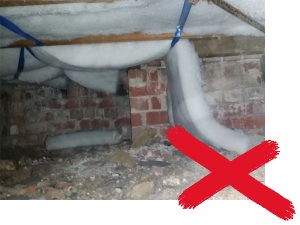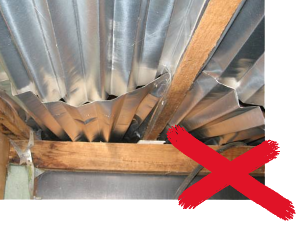Under floor
Insulation
Polyester Underfloor Insulation

We offer the highest quality polyester
underfloor insulation rated at R2.5
Underfloor insulation will:
Keep the floor warmer and stop your feet feeling cold
Stop draught coming up from under the floor
Reduce sound coming up through the floor
Shrink your energy bills as your home will useless energy to stay at a comfortable temperature
Yes, I just want to be more comfortable in my home.
Quality and Safety from the sub floor Up!

Save up to 20% of heat loss and add 1.5 Stars to your Energy Rating when you install polyester underfloor insulation.
Remember, your underfloor area is as big your ceiling! A poorly insulated floor will not protect your home from unwanted heat gain in summer and will allow your expensive heating to escape in the colder months, costing you a fortune in energy bills.
What type of insulation is best?
ecoMaster’s underfloor insulation is 100% polyester and is selected based on its exceptional quality and effectiveness. This product is high-performance, not itchy (no glass splinters to irritate under your skin or lungs), non-toxic, low allergenic, moisture and rodent resistant and maintains its loft for the lifetime of your home.
ecoMaster’s underfloor insulation comes in long rolls and two widths, which means fewer joins for the best possible coverage. Polyester underfloor insulation is manufactured from up to 80% recycled PET bottles – so it is great use of what could become a waste product. And of course, it is Australian made.
ecoMaster has worked with all kinds of insulation over 20 years and 20,000+ homes – from batts to boards and long rolls.
We don’t offer every insulation product – just the products that we have actually tested, used extensively and have stood the test of time.
We have done the research, so you can buy with total confidence.
Great product
Don’t waste your money or time with the stuff from Bunnings. The ecoMaster poly floor made a huge difference to the temperature inside the house and was super easy to install.
Sam R.
Worth it! A noticeable change in the temperature within the house since the insulation has gone in. Yay! Did the installations ourselves, aside from the equipment recommended by EcoMaster I would suggest something to play some tunes on under the house as you’ll be there for a while – but completely worth it.
Jacqui M.
Is it worth insulating under floorboards?
Without underfloor insulation, the cold air beneath your sub-floor permeates your timber floorboards making your home cold and uncomfortable. A timber floor is just 19mm thick, this combined with possible air leakage, create a heat sink beneath your home, drawing the heat out to your sub floor.
Insulation is measured in terms of ‘R’ value, which represents “Resistance to Heat”, the higher the ‘R’ value, the better the insulation. An un-insulated floor rates only R0.7. While carpet and underlay will make your feel more comfortable underfoot it only contributes slightly to the R rating (approximately R0.3), giving a total of just R1.0, which is an insufficient rating for a comfortable and energy efficient home.
Underfloor insulation will increase your floor’s R rating, and make a huge improvement to your comfort. For example, the addition of our premium R 2.5 underfloor insulation will take the overall rating of your floor up to a massive R 3.2 or R3.5 with carpet, earning a higher Energy Star Rating for your home, much more comfort for your family and much lower energy bills.
Does Underfloor Insulation Make Much Difference:
- Yes! In some homes it is life changing – in every home it has made a discernable difference
- High performance for optimal effectiveness
- Eco friendly comprising up to 80% recycled PET bottles
- Non-Irritant, non-toxic, non-allergenic
- Manufactured in Australia
- High quality solution that last the lifetime of your home
- Polyester insulation guaranteed for 50 years.
How to Proceed:
Get exactly the information you are looking for about underfloor insulation, plus instant pricing!
ecoMaster: Pioneers in Energy-Efficient Home Retrofitting
ecoMaster is recognised as a leader in energy-efficient home retrofitting, providing a range of products and services focused on home comfort, energy savings and sustainability. Our unique approach to insulation solutions is shaped by decades of experience in the industry, an unwavering commitment to environmental sustainability, and a focus on customer satisfaction.
Explores what makes ecoMaster insulation products and services unique – material quality, environmental impact, design innovation and customer-centricity.
Great product that works well and is made from a fair amount of recycled bottles
This product is really great especially for older homes with difficult to insulate the walls. The product is easy to install with an powered staple gun and lots of drop sheets to keep the insulation free from dirt. Nothing is worst than dirt falling into your eyes during installation. I am using personally using an air stapler with 14-16mm staples.
The product rips sideways with ease, which is very handy when your working within the underfloor crawl space . I did find that the product seems to have a smoother exterior on one side that is better to have facing down (externally). The other side is more “fluffy” and easier to accidentally disturb when installed.
It is significantly better to work with than regular glass fiber batts that I have experienced fixing the existing roof insulation. Effectively it is the same stuff in most pillows and is ironically comfy to lay on when having a brief rest under the floor.
The only pain personally has been installation in a 70+ years house with multiple retrofits sometimes done poorly that makes the insulation harder in some areas. Things like copper water pipe upgrades from older gal pipes that are dangling on the floor; electrical wiring upgrades with wires everywhere (old unearthed and new); and concrete stump replacements with soil piles blocking underfloor access with moving the dirt piles.
So far I have installed about 80m2 of the insulation in my home by myself on a few weekends. I have a few more rooms to do, but it is making a huge difference to the comfort of the home. The insulated floors aren’t freezing anymore and people visiting are commenting on how “warm the place is.” The product is great!
George M.
FREQUENTLY ASKED QUESTIONS
Is it better to insulate floor or ceiling first?
When deciding whether to insulate your floor or ceiling first, we suggest prioritising ceiling insulation due to its significant impact on reducing heat loss. Since heat naturally rises, most heat loss in a home occurs through the ceiling. Insulating the ceiling can significantly improve indoor comfort by maintaining a more consistent temperature and is generally easier and less expensive to install compared to floor insulation. This approach provides immediate benefits in terms of energy efficiency and comfort, offering a quicker return on investment.
However, if you experience specific issues to deal with, there is always the case for starting with underfloor insulation. These issues might include really cold floors or drafts, particularly in rooms above unheated spaces, you have a new baby who is about to start crawling or you have senior family members (who are more impacted by cold temperatures) living in your home.
Both types of insulation are important, but addressing the ceiling first often yields the most immediate and significant improvements. For more detailed guidance, ecoMaster’s technical team offers insights and advice on starting your insulation project.
You may like to ready an excellent and well received article called “I don’t know where to start” which outlines the optimal sequence for home energy efficiency retrofit.
Is it better to insulate floor or walls?
Deciding whether to insulate the floor or walls first depends on the specific characteristics and needs of your home.
Whilst wall insulation is often thought of as a priority project because walls are a significant source of heat transfer, it is a much more expensive and intrusive process that requires specialists to do the work.
Insulating the floor can provide significant benefits, particularly in homes with uninsulated crawl spaces or basements. Floor insulation helps prevent cold draughts and heat loss through the ground, which can be especially noticeable in winter.
ecoMaster suggests that if your home experiences cold floors or draughts, addressing the floor insulation before wall insulation can lead to immediate comfort improvements and energy savings. Underfloor insulation is also a much lower cost, DIY project.
Ultimately, both wall and floor insulation are important for a well-insulated thermally efficient home, but the choice depends on your immediate needs and the specific heat loss characteristics of your home.
What is the recommended underfloor insulation?
There are many materials used to insulate beneath floorboards, but none so effective as polyester rolls, stapled firmly between the joists. This has become the de-facto industry standard.
Over the years we’ve come across a variety of ineffective alternatives. All have taken many hours to install and have cost the householder hundreds if not thousands in material – with negative results.




1. Insulation batts held up with packing strap.
This quick and cheap installation method doesn’t hold the insulation firmly against the floorboards, allowing space for air flow between the material and the floorboards and easy access for rodents.
2. Reflective insulation joined end-to-end.
Does not allow adequate still air space and is virtually impossible to install the sheets end-to-end without gaps, making it ineffective.
3. Builder’s Blanket secured by mesh wires.
As you can see above, a few short years later the material is sagging (allowing air infiltration) and the product is breaking down due to water damage.
4. Fibreglass bulk insulation secured with chicken wire.
Over time, the fibrous nature of this underfloor insulation has allowed it to break down, rodents have carried some of it away and while the securing mechanism did stay in place, the material did not.
What is the best type of underfloor insulation available?
Having reviewed all of the different types of underfloor insulation available. We choose Autex Polyester for its effectiveness, longevity and non-toxic properties. Our installation technique ensures a snug fit as we staple the insulation every 100mm -150mm.

Can I install underfloor insulation myself?
Yes, you most certainly can! And we have all the information you need to achieve a great result. From advice on what type of insulation and what width is the most appropriate to installation techniques. We provide step-by-step installation videos on how to install under floor insulation to make it super simple.
We can provide an estimate on how much insulation you will need and have that insulation delivered to your home. Alternatively you may be able to pick it up, depending upon your location. ecoMaster also provides phone / chat support during the installation process if you need a bit more help.
For Melbourne customers, we even have stapler hire using the best trade quality staplers that are hired out at very economical weekly rates.
Our Technical Director has recorded an excellent Masterclass on underfloor insulation, which is free to access. Before you embark on your underfloor insulation journey, this is an excellent starting point so you are fully informed. You can even become the neighbourhood guru!
There is a whole website dedicated to every aspect of underfloor insulation click here to learn more.
What is the R Value of underfloor insulation
The R-value of underfloor insulation varies depending on the type and thickness of the insulation material used. Typically, polyester insulation rolls, which are popular for their ease of installation and durability, have R-values ranging from R2.0 to R2.5. Ratings of R3.0 and R4.0 are unavailable – but are less common. Generally, these higher R values are to achieve an overall energy rating for a home to achieve a Certificate of Occupancy or after a significant renovation.
Fiberglass batts offer R-values around R2.0 depending on their density and thickness. Reflective insulation materials, like foil-faced products, generally have lower R-values on their own, generally R1.4.
When weighing up the price of your underfloor insulation project, make sure you compare price per square metre as well as R-values.
How much space do you need for underfloor insulation?
You will need around 40cm clearance (or about knee height) to feel comfortable under your floor. Given many householders don’t hang around under their floors, it is fairly unfamiliar territory. Mostly you would be working on your back, so our rule of thumb is ‘Can you turn on your side if you need to?’. If the answer is ‘Yes‘, then you should be good to proceed with installing your insulation.
From a safety viewpoint, it is always good to have someone else either working with you or able to assist if needed.
What is the easier way to insulate a floor?
The easiest way to insulate a floor typically involves the use of readily available, clearly understood and user-friendly materials, such as polyester insulation rolls. This method is straightforward and can often be handled as a DIY project, minimizing the need for professional installation.
This method involves measuring the space between floor joists and stapling it securely to the joists. For installations from below, staple the insulation along the underside of the joists, ensuring it is tight and flush to avoid gaps.
Polyester insulation is particularly advantageous because it is non-irritant, safe to handle, and resistant to moisture and pests, ensuring long-lasting performance.
Its ease of installation makes it an ideal choice for homeowners looking to enhance comfort and reduce energy bills without extensive labour or expense.
If budget is particularly tight, or you don’t have a lot of spare time, you can install just one pack of polyester insulation at a time – making it a highly affordable DIY project.
Can you insulate under floorboards without removing them?
Yes, you can insulate under floorboards without removing them by accessing the space from underneath the house. This method is particularly effective for homes with accessible crawl spaces or basements.
Polyester insulation rolls can be fitted between the joists from below, and stapled into place. This approach ensures a snug fit and effective insulation without the need to disrupt the existing flooring.
Using a double insulated staple gun and galvanized staples, you can secure the insulation every 100 to 150 mm along the joists to prevent sagging and ensure durability.
However, if you do not have sufficient space to access underneath your home, there are several choices:
* removing the floorboards from inside (this is common in a full renovation where the home is stripped back to the frame). They are reinstated after the floor has been insulated.
* removing selected floorboards to allow access
* digging out earth between bearers to create a hollow sufficient to allow installer access. Yes – this technique is more for enthusiasts who are looking to improve their cardio vascular health as well as their thermal comfort. But it has been done by ecoMaster clients with great success.
What insulation do mice hate?
Mice tend to avoid certain types of insulation materials, particularly those that are less conducive to nesting and difficult to chew through. Polyester insulation, like the kind offered by ecoMaster, is one such material. Polyester is not only durable and moisture-resistant, but it also lacks the food value and nesting comfort that mice seek, making it unattractive to rodents. This material is also easy to install and maintain, adding another layer of convenience for homeowners looking to insulate their homes effectively while keeping pests at bay.
How do I insulate steel floors?
An increasing number of homes are being built with steel joists rather than timber. If you need to insulate your steel-framed floor, ecoMaster’s Joisties offer an elegantly simple DIY solution.
Joisties hold insulation in place and reduce thermal bridging from the steel joists. It does not matter if your joists are “C” or box sections, Joisties come with fitting tools and special “stick once” glue for easy installation.
Joisties effectively act as woollen socks for your steel joists, creating a warmer and more comfortable living environment.
Click here to learn more.
Does Underfloor Insulation attract rodents?
That is a great question, and is answered at length Ant and Rodent Proof Insulation
How to Install underfloor insulation in Australia
We are so pleased you asked! ecoMaster has been installing underfloor insulating for 20 years and has supported many thousands more to install their own sub floor insulation.
We have a specialist website dedicated to explaining everything you need to know about under floor insulation.


